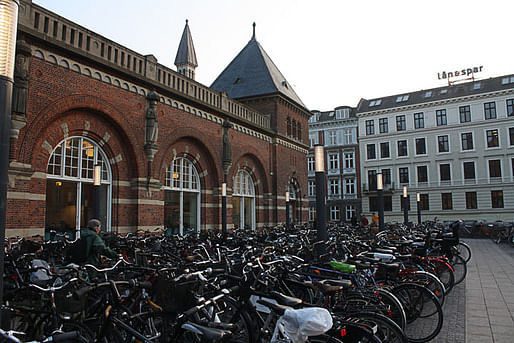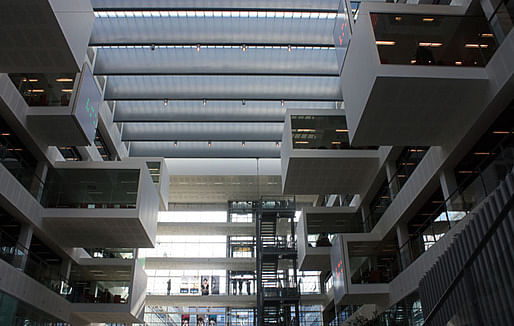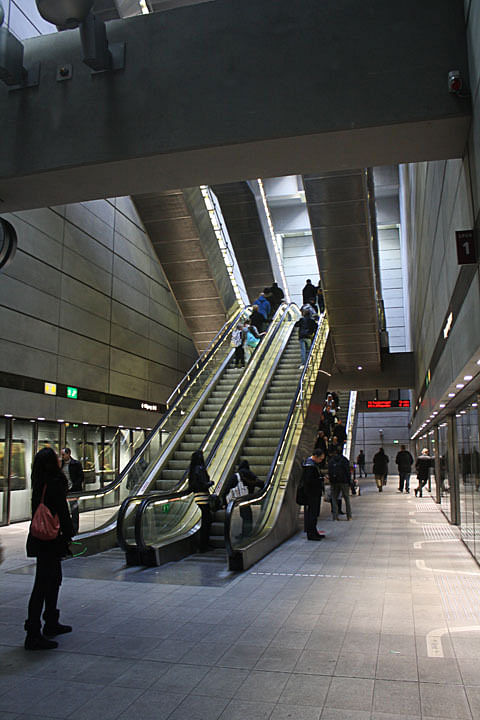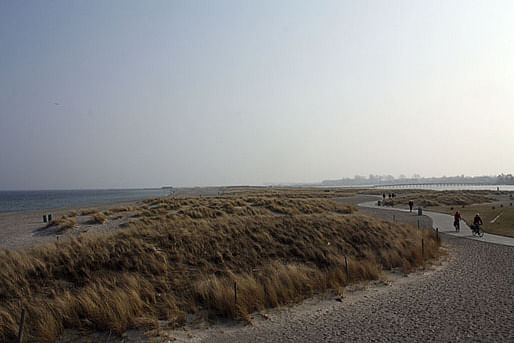
Part I of Spring Break installment
København
Back in March, the two of us ventured back across the Baltic to visit our warmer Nordic neighbors to the west. This is the first installment of three entries covering our spring break adventure.

The iconic windmills of Copenhagen
Much like Finland has bits and pieces of Russian influence in its culture, one can sense the very same in Denmark in its relation to Dutch culture: loose morals, Dutch gables and pediments, pastel colors, and canals. Denmark is the only Nordic country with a geographical connection to the rest of Europe. A cultural bridge of sorts.

Caught between the Royal Gardens the Royal Library and the Danish Jewish Museum 
Landmark Spire of Christianshavn
A city of spires, windmills, bicycles, the Danish Crown, hippy communities, and some of the most bold and optimistic new architecture and development either of us have seen, Copenhagen is at once as old as it is new. Cosmopolitan in every sense, in few other places of the world can you see beautiful women commuting on bike, in high heels, while smoking a cigarette and chatting on a cell phone. Twice the population of Helsinki (1.2 million), there is much to do, see and explore. In the six days we spent here, we never ran out of fun nor excitement.

Dragon Spire of The Stock Exchange Building
 Canals and lakes are bicycle graveyards
Canals and lakes are bicycle graveyards
An early highlight was that our arrival coincided with the tail end of a separate Sam Fox excursion to Copenhagen to study urban design strategies with Oliver Schulze, director of the Gehl Studio in Copenhagen, and John Hoal, Chair of Wash U’s M.U.D. Program and founding partner of h3studio in St. Louis. Holding semenars, workshops, and charretes in the Studio’s of the DIS abroad program (Alex studied at DIS for two semesters in his undergrad years), the students used Copenhagen and the Gehl philosophy as a laboratory and testing ground to think about the space between buildings and the idea that happiness is inextricably related to smart design. We caught the tail end of a seminar with Oliver and went out with the bunch for a drink afterwards. It was nice to reunite with some of our friends in St. Louis, and hear about their experience.

Strøget, Cph's walking street
Bike parking outside KBH Central Station
Copenhagen is the kind of city that makes you smile when you walk its streets. Not just the sheer presence of bicycles (at once overwhelming and astounding), it is a city designed for people and designed for life. The downtown is walkable to an astonishing extent, a beating heart of street life connected by a hierarchy of arteries and organs: pedestrian streets, plazas, and canals. Most notable is Strøget, the world’s longest pedestrian street. Moreso than Helsinki (a relatively young city by European standards), you sense the age of the City here, with major public buildings dating back to the 1600's. The green guild and might of the Danish King is everywhere; the stones, the streets, and the horses give constant reminder to a cultural heritage that runs deep. In the downtown, the storefronts are all sunken below street level, a result of the city having been built up on itself so many time.

Nytorv

Christiansborg Palace, it doesn't get more fairy tale than this
In starkest contrast to the sacrosanct city center, however, we have Ørestad: the daring 3 mile strip of open land that is being aggressively developed in three tiered stages. An escape from the city core, the idea is that withing a few minutes on the metro, one can leave the city entirely to a more suburban model. This place is fascinating. It is BIG in every sense. The first portion consists mostly of University buildings, with a large void in between, the next phase of development is housing, consisting of many earlier Bjarke Ingalls developments including the VM houses and the Mountain homes. 
University Campus of Ørestad
Henning Larsen's IT Tech Student Center
Tietgenkollegiet by Lundgaard & Tranberg


Consisting of 360 rooms, this student housing complex is divided into 12 person "communities", each sharing a common kitchen and living space that looks into the central public courtyard. The bedrooms all face the outside, as to maximize privacy.
 Aggressive Porches of BIG's VM Housing
Aggressive Porches of BIG's VM Housing Massive, bold, and dare we say, clunky? Mountain Homes. It's hard to fully evaluate this development, because we could not sadly, get inside.
Massive, bold, and dare we say, clunky? Mountain Homes. It's hard to fully evaluate this development, because we could not sadly, get inside.
The development culminates with another series of housing projects on an even larger more ambitious scale, including Bjarke Ingalls 8 House development, a monster on its own. We were pleasantly surprised to find that the 8 House was completely open to the public to walk throughout, and indeed, one can explore virtually every nook and cranny of the overwhelming complex through its series of snaking ramps and stairways, an internal pedestrian street of sorts, separated by soft porch buffer edges. Bjarke is reimagining the idea of the townhouse within the traditional Danish housing block, and in some respects, he is very successful. The southern courtyard was full of life, children playing, and people engaging in life. However, the northern, deeper courtyard, was a dark, deserted void, lacking life, and feeling depressed. Many of the homes were still empty but a significant number had big “SOLGT” signs on the door, so I imagine it is going to fill. The average 1.5 bdrm apartment was selling for about 2,000,000 DKK, or $350,000… most apartments we could see consisted of an open kitchen | living space with a bedroom and studio room upstairs. Each floor has views to the courtyard and to the street beyond. 
8 House Cafe Entrance



Detail of interior rooms
Our biggest problem with the building is its sheer mass. The rational layout that BIG designed causes the exterior to look haphazardly bulky, heavy, monstrous, and often clumsy. Regardless, it was a sight to see, and as seen from the photos, it gives a sense that it is far from the city. It will be interesting to come back in ten years and see how this enormous experiment ages over time.
Semi-private buffer patios to public internal street ramps. Note the bike parking.


Classic BIG branding
Escape from courtyard into nature

Neighbor to the 8 House, under construction
Parkour Park, dirt jumps, and multi-function playground for residents of Ørestad... note the massiveness of 8 House in background
The Metro System of Copenhagen is operated electronically, and riding the rails is very fun with the large front windows.


Deep, naturally lit, clean stations
Additional Sights, Sounds, and Observations of Copenhagen:

Pedestrain | Bicycle Bridge

Øresunds Beach
Øresunds Beach

Prismen Community Gym Extension
Rosenborg Castle
Christiansborg Palace Square
In the portico of the State Museum of Fine Art
Bizarre Taxidermy Model Store... unfortunately it was closed...

Youth sailing club, one of BIG + JDS's (formerly PLOT) earlier works Looking towards Freetown of Christiania, Denmark's "Greenlight District"
Looking towards Freetown of Christiania, Denmark's "Greenlight District"  Richard Serra's "Gates at the Gorge" at The Louisiana Museum outside of KBH
Richard Serra's "Gates at the Gorge" at The Louisiana Museum outside of KBH
Nordea Bank Headquarters, Henning Larsen Sundby Bibliotek Extension
Sundby Bibliotek Extension Gemini Residence, MVRDV - Housing converted from an old Gasometer (we think)
Gemini Residence, MVRDV - Housing converted from an old Gasometer (we think)


Outside the "Black Diamond", the addition to the Royal Danish Library

Interior of the Black Diamond, looking out
A beautiful city. As the slogan goes, good water, good life, copenhagen.

This work by A.D.Morley & J.A.Wong is licensed under a Creative Commons Attribution-NonCommercial-NoDerivs 3.0 Unported License.
A new adventure begins as we finish one chapter; we hope to share our story with you. We are graduates of Washington University in St. Louis, Sam Fox School of Design & Visual Arts.
No Comments
Block this user
Are you sure you want to block this user and hide all related comments throughout the site?
Archinect
This is your first comment on Archinect. Your comment will be visible once approved.